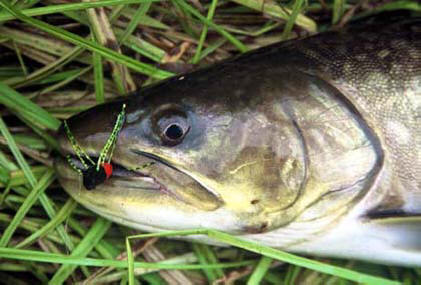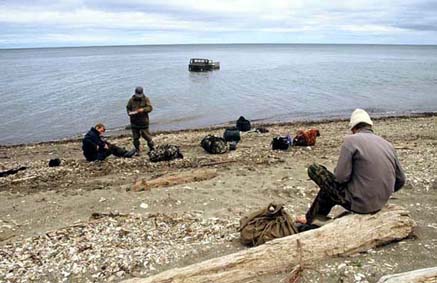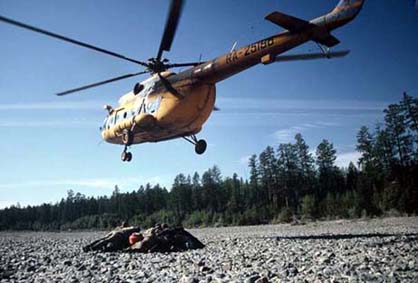
This is a chapter of the book "Flyfishing the Russian Far East". Materials were published in the Nakhlyst magazine (#1, 2004, in Russian)
Your first journey to the Russian Far East (part 1)
Travel and flyfishing in the Russian Far East

This is a chapter of the book "Flyfishing the Russian Far East". Materials were published in the Nakhlyst magazine (#1, 2004, in Russian)
Your first journey to the Russian Far East (part 1)
Many sport fishermen, living in civilized countries, dream about traveling to the wild places. There are plenty of unpopulated and unexplored places in the Russian Far East. Chukotka... Amur... Kamchatka - any of these names is a true call for the journey. Finally, you have decided to go. Now it is time to answer some important questions: What will be the goal of the trip? Where to go? When? How?
Let us first find out, what type of fishing interests you the most. Lots of fishermen, if they go that far, will chase a record - "the fish of the life". Eastern Siberia and Russian Far East are huge regions with diverse fish fauna, so the choice is rather complicated.
Do you need to catch many fish every day, or 2-3 trophy specimens a week will satisfy you? My personal opinion is, that the river where you can catch 5 good trout a day is more interesting than the one, where you can have 50 hookups. Which are your requirements to the environment? Do you necessarily want to be surrounded by jaw-dropping landscapes? I remember how one US fisherman has canceled his trip for Kamchatka steelhead after seeing the slides of the area Ц nice, but rather bleak, flat and treeless tundra. What are your preferences about seeing animals, especially big game? In the Far East and especially in Siberia you will not see big animals in numbers comparable with the national parks of US or Canada.
If you want to fish first of all for salmon, you should plan a trip to the Pacific coast. In the same rivers there will be the ubiquitous Dolly Varden charr - the range of this fish is even bigger comparing with Pacific salmon. Together with salmon and Dolly Varden charr could dwell other fish. Depending on the region these could be other charr species, grayling, lenok (Siberian trout), Siberian taimen, sea-run (Sakhalin) taimen, rainbow trout, or inconnu (sheefish). To say just "Pacific salmon" is not enough - this genus consists of 6 species, which are very different. The total number of salmonid species, interesting for a flyfisherman, in the Russian Far East is over 20! Besides that, we have several species and subspecies of grayling, various whitefishes, 2 species of pike, very diverse representatives of the carp family, catfishes, perches... Only in one drainage, Amur River, there are over 130 fish species, among which there are many specialized predators. Add marine fish fauna, which I was not even going to mention...

In many rivers of the Pacific coast the biggest fish is white-spotted charr Salvelinus leucomaenis
Salmon trip should be planned to the areas situated close to the river mouths, not far from the sea. After entering fresh water all salmon are gradually becoming dark: they loose silver color and part of their strength, and their aggressiveness to the lures and flies is decreasing. Pacific salmon normally die in 1,5-2 months after entering the river. It is much more sport and fun to fish for silver salmon fresh from the ocean.
When planning a trip for salmon, take into account the season and water temperatures. In the south of the Russian Far East the water in many rivers by July is about 18-20*C. In such conditions salmon are sluggish and do not take much interest in flies or lures. This is why in mid-summer or first weeks of the fall it is smarter to go to Magadan, Okhotsk district of Khabarovsk region, or to Kamchatka. The water in rivers is here cold and comfortable for salmon even in summer. The best time to fish in Sakhalin or Primorie will be June, September and even October, when it is already too cold in the North.
Migration patterns of the sea-run (Sakhalin) taimen and charrs are more complicated comparing with Pacific salmon. The duration of their live is much longer than by salmon, and they normally do not die after the first spawning. These fish species can go out into the sea and back into the river several times in one season. This means, without good knowledge of the place and time you will not have good chances for success. A novice can barely have good fishing without an experiences guide.
If you want to catch Siberian taimen and lenok, it is better to plan a float-trip. I think, this is a very pleasant way to travel: there is no noise from a motor, but the rafts can carry enough gear to ensure a sufficient comfort at the camp. Only on some bigger rivers it is better to use motor-boats. The navigable rivers are normally too big. The best water for flyfishing is a stream too small for a propeller outboard. This is why the combination of a helicopter and common rubber raft will allow you to fish in the very upper reaches of a river - the areas, which no motor-boat can reach.

In our region you can expect to catch trophy Siberian taimen (Im River)
In the Russian Far East there are tens of thousands of lakes and rivers, tremendous extension of unpopulated sea coast. Only on some waters out of this multitude there is information which fishermen can use. The data on flyfishing are especially limited; imaginary "map for a flyfisherman" is mottled with numerous blank spots: in many rivers nobody has even tried to fish with a fly rod! I think, this makes our region especially attractive for a true fisherman, for a person with an adventurous mind - here you can become an explorer! Many of the world class rivers were discovered by the flyfishing world not long ago. For instance, the first fly was cast into the water of the Utkholok River in 1995, and of the Sopochnaya River - in 1996. This means, it is not difficult to visit a completely unstudied river and to become the first!
On the other hand, the shortage of reliable information makes the trip less predictable, requires from a fisherman lots of inventiveness and flexibility, skills to change the fishing tactics. Quite often you have to remember and use in practice the knowledge from a book, read long ago. There is no information on flyfishing for some of the fish species of our region. For example, we are only starting to feel about for the flies and catching methods of such unique species as cherry salmon, Siberian and Sakhalin taimen. Even less information is available on predatory and omnivorous fish of the Amur River.
Try to estimate you casting level. My first experience in the Florida flats was disappointing Ц I understood that my skills were inadequate Ц I couldnТt cast as far and exact as was necessary, and wasnТt able to deal with the wind. If you want to catch trophy taimen, be prepared to many hours and days of fishing with big (BIG!) flies, which you should be able to present on the necessary depth.
Think if your fishing persistence is sufficient; some types of fishing (chinook salmon, Amur predators or taimen) will require it in great amount. Many fishermen are used to have enough action during the day, which helps them from getting bored. Long hours of casting with a heavy rod (which tires you and adds irritation) will expend all reserves of your persistence quite soon. Some fishermen as early as on the second day will put away the fly rod and shift to spinning gear Ц to catch at least something and somehow.
One more important requirement to the fisherman is his physical condition. Some ways to catch fish expect from us a lot, and the flyfishing is among them. Surely the fishing conditions may differ, so think on what you will get in the end. In some places of our region you are able to sleep in heated cabin and go fishing with a motor-boat after breakfast, served in nice dining-room of the lodge. A big difference with crawling out of a small, ice covered tent into morning chill, longing to warm your hands near the fire and hoping that the trip companions did not drank all coffeeЕ
One more consideration - for the trip success you will need some luck. Even perfect trip logistics can face something like "wrong" weather, and the journey will become a misfortune - or disaster, name it. For instance, a heavy rain could spoil the fishing for a week - on some types of rivers.

Many areas of the region are reachable only by air (Tugurski peninsula)
Well, you are ready to go. The simplest way is to contact one of the tourist firms, which are now quite numerous in the Russian Far East. Besides, such trips are organized by some firms and clubs of the European Russia. The choice of the firm to work with is not easy, it is better to try to get references. In the tourist business not every firm is skillful and responsible; it is not difficult to fall into the hands of non-professionals. Besides that, you should keep in mind, that flyfishing in the region is still not popular. Many local outfitters and guides have never worked with fly fishermen, can not estimate which river will be the most suitable for this fishing method. Try to find out, the water of what size and depth you will face, how the banks look... If the guide is used to work mostly with spin-fishermen, he will often stop the boat in the "wrong" places.
If you are going to fish from a boat, be sure that the outfitter will not place more than 2 fishermen into one boat. In any case try to get as much information on the area where you will travel as possible - from all available sources. This will help you to make correct choice of equipment and clothes. In such complicated "affair" as wilderness trip even a small point can determine the difference between success and disaster.
Which of our fish species are unique?
1. Siberian taimen
2. Lenok
An alternative destination to catch these fish is Mongolia, but the possible maximum size of the trophies in Russia is bigger, and in some streams the average size of your catch will be impressive. What about fishing for 55-cm-average lenok with dry flies, with everyday catch of 75 cm (30") fish?
3. Cherry salmon.
Trophy fish up to 9 kg (20 pounds) could be caught only in several rivers of the Northern Primorie and nowhere else.
4. White-spotted charr (kundzha)
This bull trout-like predator is found in Japan, but its size here is never as big as in the Eastern Kamchatka or near Magadan.
5. Yellowmouth charr
The range of this rare charr is limited to 3 river drainages of the Sea of Okhotsk.

The truck went down in the sea, so the passengers have had to wade to the shore in cold water (Sakhalin Island)
Tackle:
This is an important question - which rod should you take along? There are 3 main classes of fly-tackle, most useful in our region:
1. Trout rod - one-handed 5-7 weight tackle. This rod with a floating line can be used for grayling, lenok, rainbow trout, different charr species, pink salmon, cherry salmon from Sakhalin and Kamchatka. This tackle will be too light for big white-spotted charr, salmon and other fish bigger than 5 kg. Nevertheless, a skillful fisherman in favorable conditions can land with it a rather big fish - good chum or coho salmon or a taimen up to 1 meter long.
2. Salmon rod - one-handed 8-10 weight tackle. These powerful rods allow to fish for all Pacific salmon including chinook, steelhead, big charr, pike... In our region it is often necessary to use big streamers and mouse patterns, which makes salmon rod the main tool to fish in big rivers and lakes. It is most suitable for the predators of the huge Amur River - catfish, pelagic cyprinids, and Amur pike. Salmon rod will allow to catch taimen as well; only very big specimens can cause troubles. By the way, the most difficulties in taimen fishing are caused not by landing, but by casting of very big flies and by necessity to fish near steep banks. This problems can be solved by using of a two-handed rod.
3. Two-handed 9-11 weight rod 14-16 feet long. This tackle is especially handy for big rivers, where long casting is required. It will help a lot when fishing in deep places with long and heavy sink tips or shooting tapers. If you have decided to buy such a "long Bertha", learn spey-casting. In this case much less places in any river will remain for you non-fishable. When a fisherman masters his spey-casting skills, his single-handed fishing style is changing as well: all these casts can be easily executed with any rod type.
If you like to use the lightest, 2 or 3 weight rod, take it along, especially if you plan to travel far from the sea coast. In the inland areas the probability of calm days, when such a rod could be used, is much higher. On the other hand, here is no necessity to use this light tackle even in clear shallow water - our trout and grayling are "unsophisticated".
Light two-handed tackle (6-7 weight, 11-13 feet long rods) are not popular in Russia, but they can be used with success, especially for surface or subsurface fishing with a dry line. The most handy lures for such rod will be big dry (skating) flies, small mouse imitations and streamers.
Carry backup - take along at least two rods. These could be one trout rod and one - of a salmon class. Or bring one two-handed rod and 1 or 2 single-handed. Carrying only one rod is not a good idea: in most towns of Russia it is impossible to buy any fly-tackle. The fisherman who breaks his only rod will "leave the ranks" till the end of a trip.

Helicopter leaves after dropping fishermen, their gear
Flies
Here I will make a brief overview of what I always carry in my fly-boxes.
1. Skating or waking patterns like Lenkovka, Bomber, etc. I tie these flies on the hooks of different size. Dark flies on # 2 to # 14 are good for salmonids, white ones (#2-6) Ц for Amur predators.
2. Goddard Caddis # 6-16 (natural color) and # 4-6 Ц red and black.
3. Classic nymphs # 8-14 Ц weighted and unweighted, dark natural colors.
4. Goldhead nymphs # 8-14, natural colors.
5. Salmon fry imitations: 3-6 cm long, simple streamers, made mostly of silver and (or) pearlescent Crystal Flash. You will need both unweighted patterns, and weighted, made on nickel-plated bottle-type tubes.
6. Wooly Bugger # 4-6 Ц black, olive and white.
7. Streamers # 6-1/0, light colors (silver, pearl and yellow).
8. Articulated Leech (String Leech) # 6-2/0 Ц black.
9. Pike flies # 1-3/0.
10. Taimen flies (articulated streamers and big "mice").
Home Fishing Flies Books & Articles Articles, posted at this web-site Fishing tours About the author
FLYFISHING, OUTDOOR TRIPS, WILDERNESS PHOTOGRAPHY